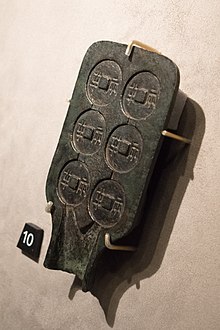Ban Liang

The banliang was the first unified currency of the Chinese empire, introduced by the first emperor Qin Shi Huang around 210 BC. It was round with a square hole in the middle. Before that date, a variety of coins were used in China, usually in the form of blades (knife money) or other implements, though round coins with square holes were used by the state of Zhou before it was extinguished by Qin in 249 BCE.
The banliang corresponds to a "half tael" (半兩), or twelve zhu (銖, about 0.68 gramps). It typically weighs between ten and six grams, roughly corresponding to the Greek stater.
The standardization of currency with this round coinage was part of a broader plan to unify weights, measures or axle width during the Qin empire.
External links
